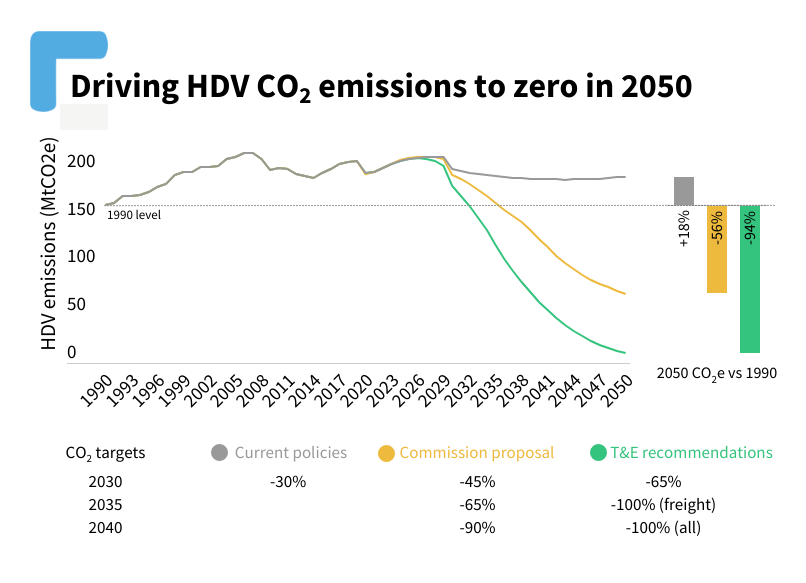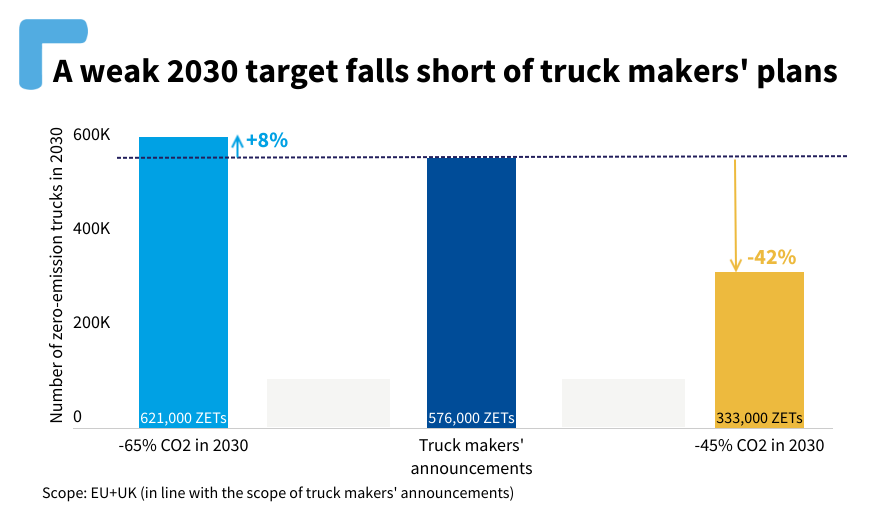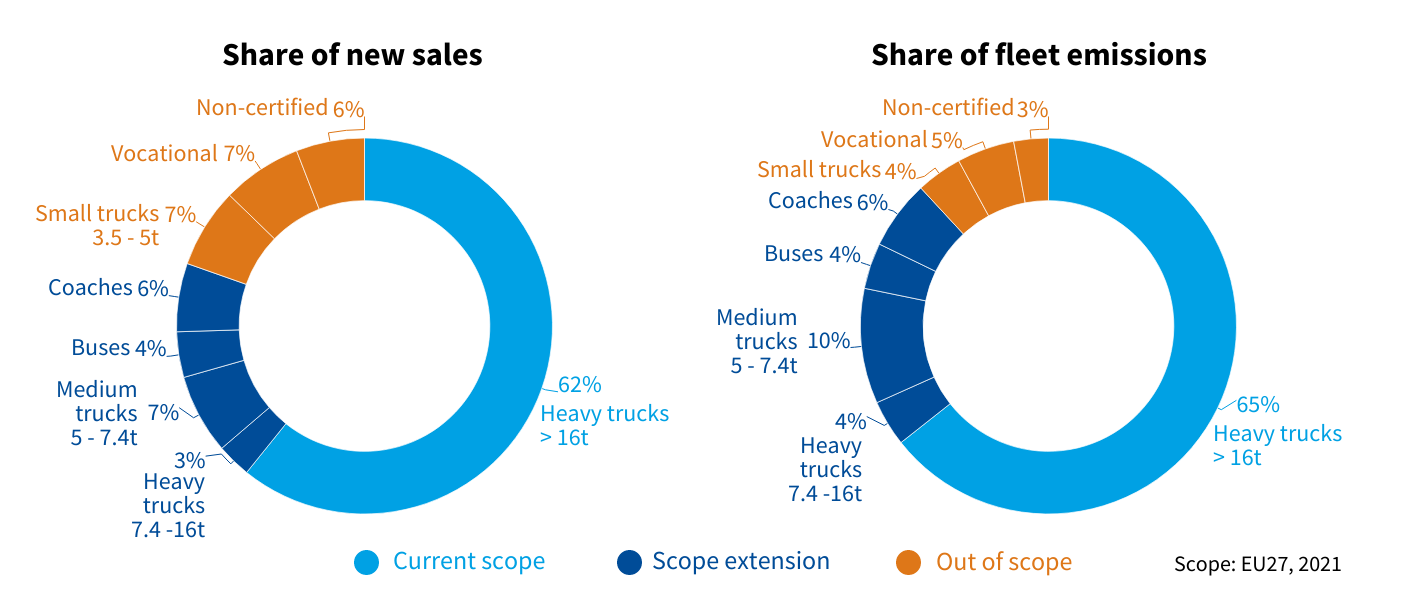The European Commission’s proposal to review the CO2 emission standards for new heavy-duty vehicles (HDVs) is the most important legislative initiative to regulate climate emissions from trucks and buses in Europe. HDVs – or all road vehicles above 3.5 tonnes moving goods and passengers – are responsible for 28% of climate emissions from road transport in Europe, while accounting for only 2% of the vehicles on the road. If no action is taken, these emissions will continue to grow.
To reach climate neutrality by 2050, trucks and buses need to be entirely decarbonised. Zero-emission vehicles (ZEVs) – which include battery electric (BEVs) and fuel cell electric vehicles (FCEVs) as well as hydrogen combustion trucks – are the only available technology which can cut emissions from new sales quickly, fully decarbonise the heavy-duty sector in the long-term, and eliminate harmful air pollution. The Commission proposes to increase their sales through a -45% CO2 reduction target for HDVs in 2030, a -65% target in 2035 and a -90% target in 2040.
The shortcomings of the Commission proposal
A CO2 target of -90% might seem close enough to full decarbonisation at first sight. But due to a number of shortcomings, the proposal would only reduce emissions from HDVs by 56% until 2050 (against 1990 levels). This both fails the EU’s climate ambitions and Europe’s chance to retain its industrial leadership of the sector. While the Commission proposal brings a number of improvements compared to the current regulation, it is falling short in four key aspects.
- It lacks a 100% zero-emission target
The Commission proposal fails to bring forward a 100% zero-emission target and instead stops at a -90% CO2 reduction target in 2040. T&E analysis shows that the proposal would only reduce HDV emissions by 56% in 2050. In contrast, setting a 100% zero-emission target in 2035 for freight trucks, buses and coaches, and in 2040 for vocational and non-certified vehicles, would reduce the sector’s GHG emissions by 94% by 2050.

Analysis by TNO (and commissioned by T&E) shows that this is feasible from a technological and cost perspective. By the 2030s, all new sales in the freight segments will have a lower total cost of ownership (TCO) compared to diesel while delivering the same capabilities in terms of range, payload and driving times (including for long-haul trucks, and across all European markets). Co-legislators should therefore:
- Increase the global CO2 target from -65 to -100% in 2035 for trucks, buses and coaches
- Its 2030 target is too low and lags behind industry plans

Although the Commission proposal increases the global CO2 target for trucks, buses and coaches from the current -30% to -45% in 2030, this falls well short of what is needed to ramp up the supply of clean trucks and buses fast enough. T&E analysis shows that an increased global CO2 target of -65% in 2030 would result in just 8% more zero-emission trucks on European roads than what truck makers have already publicly announced to produce until 2030. Co-legislators should therefore:
- Increase the global CO2 target from -45 to -65% for trucks, buses and coaches in 2030
- It leaves 20% of HDV sales unregulated
The proposal continues to exempt small trucks as well as the so-called ‘vocational’ and ‘non-certified’ vehicles. This means that climate emissions from vehicles that drive in our cities every day, including delivery, garbage and construction trucks, are not regulated at all. Together, these exempted vehicles make up almost 20% of HDV sales and 12% of fleet emissions.

Small trucks, vocational and non-certified vehicles should also be included in the regulation and contribute their fair share to decarbonising the sector. Vocational vehicles should be regulated by a CO2 target. Non-certified vehicles, including small trucks, should be regulated by a ZEV target, which requires manufacturers to sell a certain share of ZEVs from a given year. Co-legislators should therefore:
- Introduce CO2 targets for vocational trucks of -35% (2030), -85% (2035), and 100% (2040)
- Introduce ZEV targets for non-certified trucks of 30% (2030), 80% (2035), and 100% (2040)
- It defines trucks running partially on diesel as zero-emission
Contrary to the CO2 standards for cars and vans, the current definition of what counts as a zero-emission vehicle (ZEV) under the HDV CO2 standards also includes internal combustion trucks which run exclusively on hydrogen. However, the Commission proposal is changing this definition to also allow for hydrogen dual-fuel engines running partially on diesel to qualify as zero-emission. While it is reasonable to define internal combustion trucks which are running exclusively on hydrogen as zero-emission, it is not acceptable to give the same label to trucks which still (partly) run on diesel Co-legislators should therefore:
- Change the ZEV definition back to 1 gCO2/kWh as set in the current regulation
Why the Commission is right not to include fuels
A crediting system or carbon correction factor for so-called ‘renewable and low-carbon’ fuels, including advanced biofuels and e-fuels, should not be included in the HDV CO2 standards as these fuels will remain scarce and expensive, will not help reduce emissions due to sustainability issues and would risk creating regulatory loopholes.
Using e-fuels in the road freight sector is inefficient and unnecessary as cheaper zero-emission alternatives exist. E-fuels would be the most costly compliance option for vehicle makers, transport operators and society as a whole. T&E analysis shows that the TCO of diesel trucks running on e-fuels would be around 50% higher than the TCO of battery electric trucks, even when assuming that those e-fuels would be produced more cheaply in North Africa or other favourable regions and imported to Europe.
Industry headed for zero emissions, but certainty needed
While the EU as a block is just starting to negotiate the direction the regulation should take, 10 EU countries have already pledged to transition to 100% zero-emission HDV sales by 2040 (AT, BE, HR, DK, FI, IE, LT, LU, NL and PT). They have done so under a Global Memorandum of Understanding, which was also signed by the United Kingdom (UK), Norway, Switzerland and Turkey, as well as Canada and the United States. California, whose emission standards are commonly followed by other U.S. states, has recently proposed legislation for a 100% zero-emission sales target for trucks and buses already in 2036.
Today, Europe’s truck manufacturers are world leaders in developing commercial vehicle technology. They have established a growing presence in global and emerging markets, including the U.S., China and India. Failing to set a target to reduce CO2 emissions from new trucks and buses by 100% would put Europe’s technological edge in the heavy-duty segment at risk just when the U.S. is joining China in the race for industrial leadership following the Inflation Reduction Act. In the worst case, it could lead to Europe’s domestic automotive and supplier industry falling behind and losing its global leadership to the growing competition from overseas.
The HDV CO2 standards are the key supply-side policy to mandate Europe’s truck makers to invest, manufacture and sell clean trucks. If co-legislators in the European Parliament and Council do not agree on more ambitious CO2 standards, they would fail to send the necessary signal and create investment certainty for Europe’s industry.
For more details, download the position paper.


